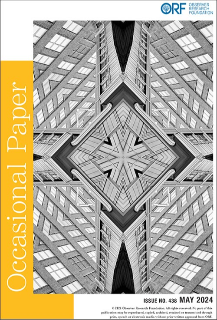The January 6 incident in which two Indian soldiers were killed in the Mendhar sector of the LoC in Jammu & Kashmir, one of whom, Lance Naik Hemraj was decapitated brutally, has led to national responses from India and Pakistan more or less on predictable lines. An incident that gathered the Indian media spotlight due to the associated brutality - assumed larger proportions as it reinforced the perception that India was a weak state endowed with self-serving political elite unable to take "hard decisions" against the repeated transgressions of the adversarial neighbour Pakistan.
Tapped efficiently by the media - the issue snowballed with government caught largely offguard with the sheer intensity of the outburst of nationalistic, and, often jingoistic sentiment.
Predictably, the Army and the Air Force spoke in terms of militaristic solutions and advocated a tit-for-tat response that stood short of escalating to a conflict (but could willy-nilly do so). Fortunately, External Affairs Minister Salman Kurshid displayed a mature outlook. While condemning the issue he also advised restraint in the same breath. Thus India spoke with differing voices sending mixed signals. While some talkative hot heads demanded nothing short of war - a fairly outrageous demand given the circumstances and the known Pakistani first-use policy on nuclear weapons, others demanded ten heads of Pakistani soldiers as an apt retaliatory measure.
As is his tendency, Prime Minister Manmohan Singh took his own time coming out with a statement defining the Indian official position. The Indian PM, after a delay, sent out negative signals to those with hopes of peace. Nobody missed the hardline stance which was tucked into it. His statement was probably made at the instance of the jingoistic groundswell that had emerged thanks to the uni-dimensional reports put out by the Army.
However, while this sabre rattling (regrettably initiated by India) led to the suspension of the new visa regime, the picture was quite different on the other side. In Pakistan this week, developments far more significant to the existence of the nation were consuming everybody’s attention. Fears of a "judicial coup" coup swept the nation as the Prime Minister was ordered arrested. Military-backed hardline cleric Tahir-ul Qadri, tried to do an Anna Hazare act, putting governance on a tailspin. The Pakistani media, logically enough, had better things to do than match word for word with its Indian counterpart. The tragedy in Quetta, Balochistan, where Sunni extremist suicide bombers killed nearly 100 people, mostly Hazara Shias, in a bombing claimed by Lashkar-e-Jhangvi, combined with the ’cliff’ situation in the polity, reduced the drama along the LoC to a B-grade Bollywood movie.
Thus proving that Pakistan was deeply engrossed with its own internal disturbances and that the border issue was a fringe element in their current occupation.
Had the Indian media over hyped a local incident? This, after all, is not unusual in a "hot and active" LoC. So, no wonder, the media’s obsession was a centrality. After all it is well known that both the Indian and Pakistani armies are deployed eyeball to eyeball along the LoC - terrain that is hostile and at times unforgiving.
In such conditions, when peace prevails, there is a sense of sympathy - even friendliness between the two sides. However, often, especially when conditions are conducive, the desire to push infiltrators into the Indian territory leads the Pakistani Army to provide covering fire which in turn makes the border "hot and active" with retaliatory fire and casualties. In such conditions both sides charge each other with "transgressions" into each other’s territory and placing of mines as had been done by the Pakistanis in the recent case. These are predictably followed by flag meetings that see the trading of charges, counter charges and complete denials of any wrong doing that are often de rigour. Once these meetings are over, its business as usual.
Grisly dimension
Despite this, cases of beheading and other such brutal actions are relatively rare though not unknown. A similar beheading case happened with two Indian soldiers (Havildar Adhikari and Lance Naik D Singh) in Khupwara dist in July 30, 2011.
In the current case the reason of this viciousness lay with the commandoes of the Pakistani Special Services Group (SSG) (also called the "Black Storks") who are more prone to brutality, given their compulsion to maintain the aura of "terror" and invincibility around themselves. This commando unit was earlier involved in the savage torture of Lt Kalia and other Indian soldiers who were captured in the early days of the Kargil conflict.
As the sequence of incidents unfolded, Pakistan has blinked first, asking for comprehensive talks at the foreign minister level while sending orders for restraint among Army units deployed. The question however remains as to how long this correctional effort would last.
It must be remembered that the ceasefire along LoC has not really solved any of India’s problems. While it has lulled the political elite in India with a false sense of complacency - the fact is that peace along the active LoC has become a mirage.
The desire to retaliate is often overpowering especially when the firing is "unprovoked" . During the mandatory flag meetings which follow, efforts are made to open a channel for communication and reiterate confidence building measures, but the reality is that they produced less than tangible results. Far from ensuring lasting peace, they only lead to regurgitation of old rhetoric. The developments of the past fortnight have reinforced the cynicism which has crept into the conflict rubric. Pakistan denies transgressions, while India breathes fire and brimstone. After the wearisomely familiar exchange of polemics, both sides return to the status quo ante.
Hence, there exists a dire need to look beyond the existing CBMs of providing advance warnings for military exercises and ballistic missile tests which are relatively "high level" issues. To solve the border ceasefire violation issue, the weekly telephonic discussions between the DGMOs and flag meetings are inadequate in keeping pace with the number of violations.
India needs to propose a framework for high-level consultations and a definite agreeable methodology for prevention of escalation and proposing de escalation in case the issue goes out of hand. A regular review of the situation on the LoC would prevent a repeat of the prescriptive chronology of events and manage the problems before they escalate. Since a conflict with a trigger happy nuclear armed Pakistan will upset the developmental agenda of entire South Asia and not only India and Pakistan.
(PK Ghosh is a Senior Fellow at Observer Research Foundation. He specialises in military security)
Courtesy: The Pioneer,
The views expressed above belong to the author(s). ORF research and analyses now available on Telegram! Click here to access our curated content — blogs, longforms and interviews.




 PREV
PREV

